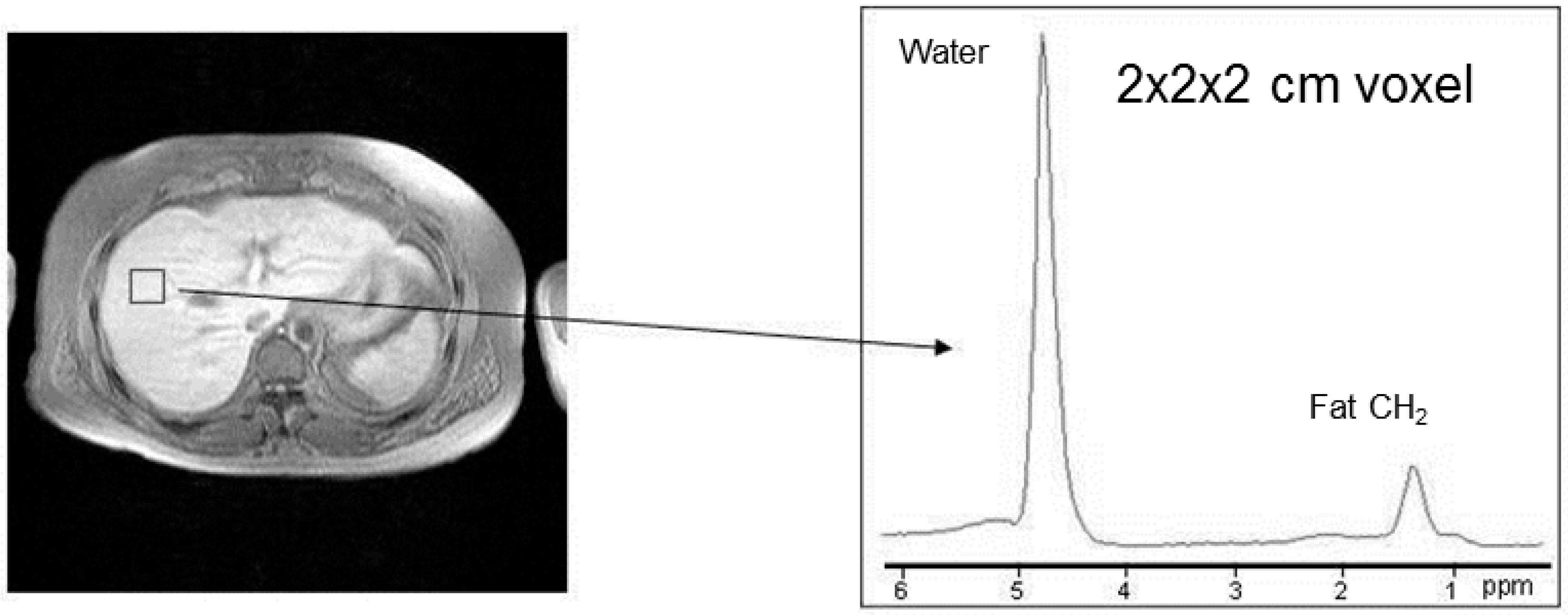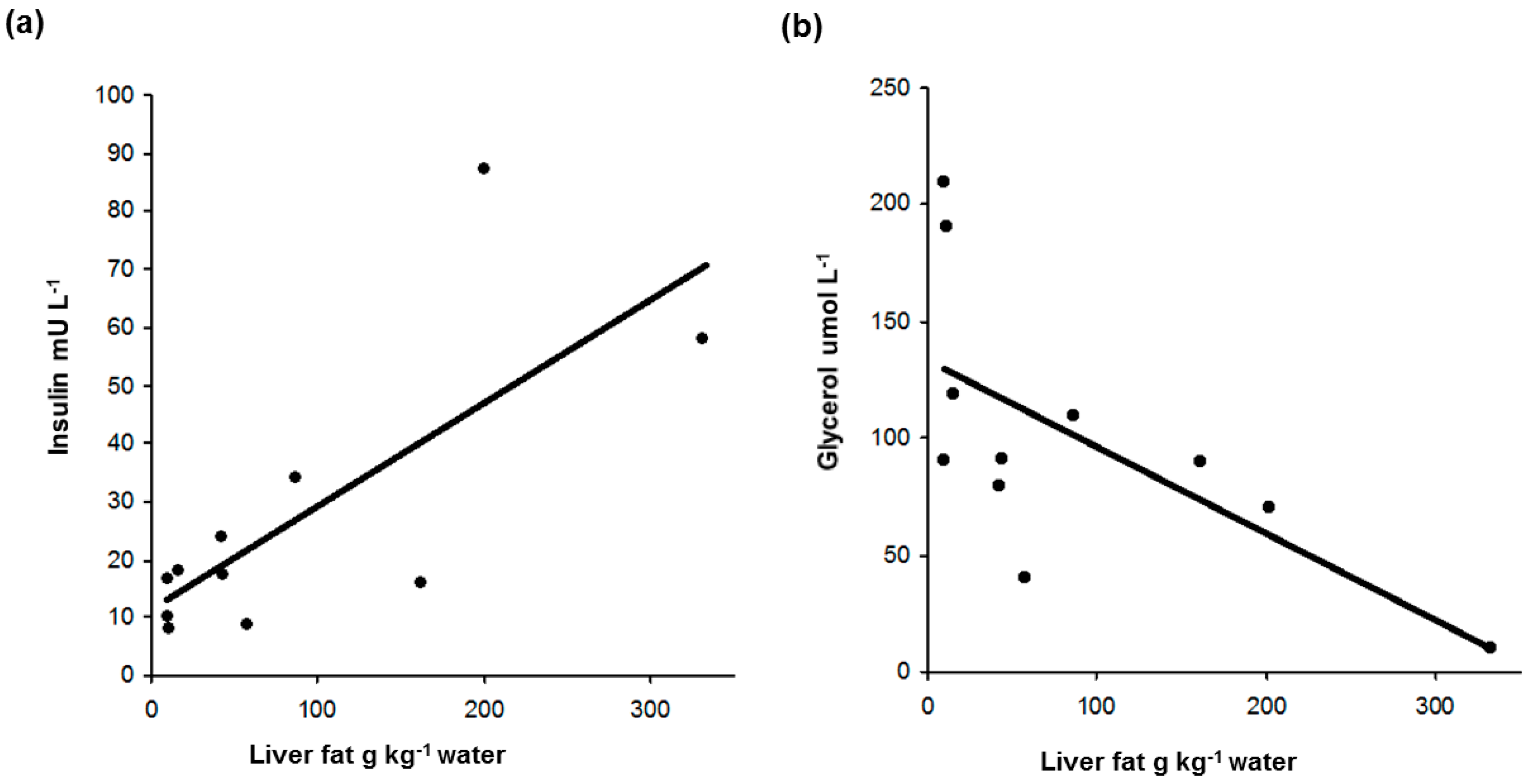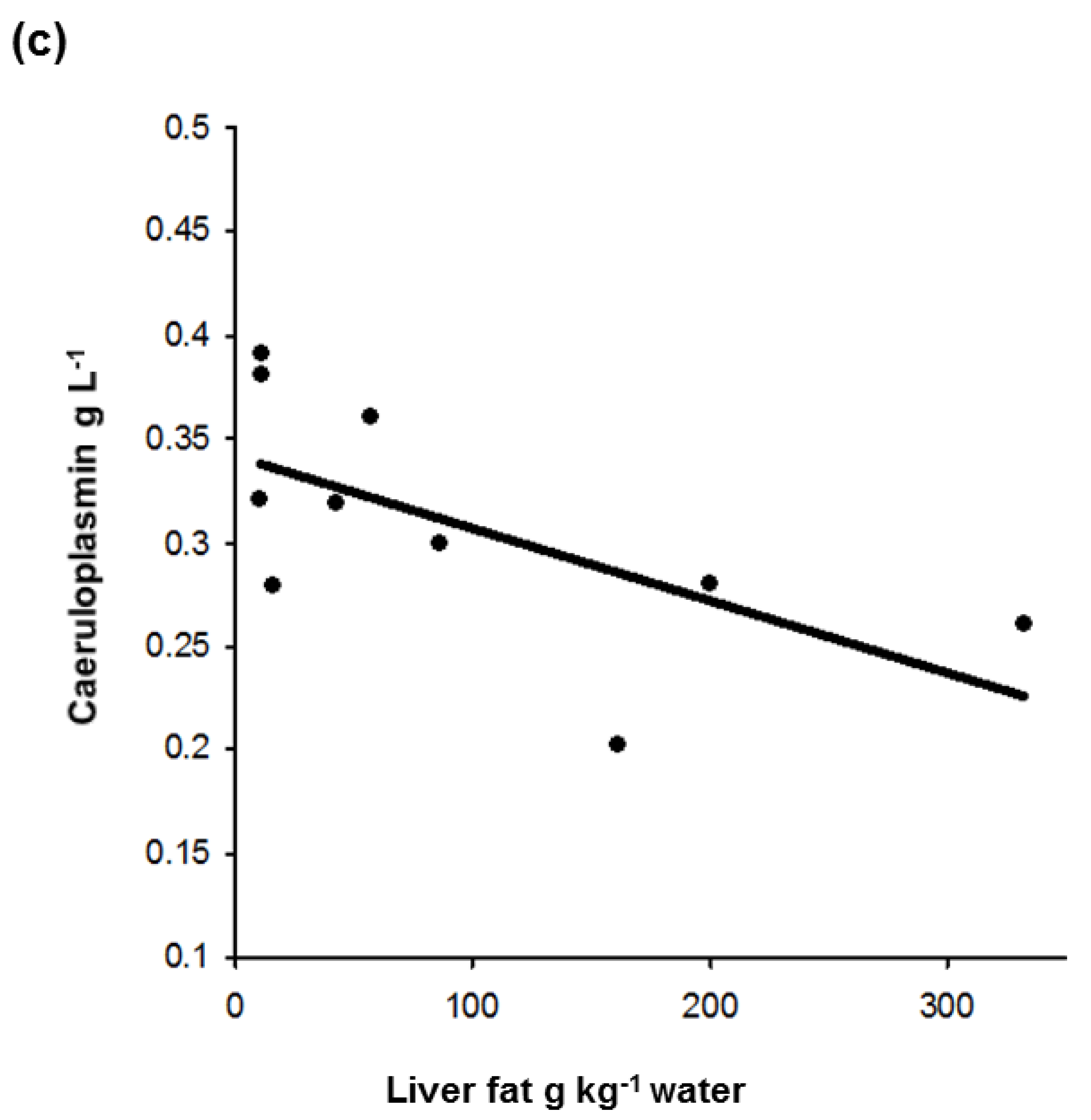Liver Fat Measured by MR Spectroscopy: Estimate of Imprecision and Relationship with Serum Glycerol, Caeruloplasmin and Non-Esterified Fatty Acids
Abstract
:1. Introduction
2. Results
3. Discussion
4. Materials and Methods
4.1. Subjects
4.2. Laboratory Methods
4.3. Estimation of Liver Fat
4.4. Statistical Methods
5. Main Messages
Acknowledgments
Author Contributions
Conflicts of Interest
References
- Kopec, K.L.; Burns, D. Nonalcoholic fatty liver disease: A review of the spectrum of disease, diagnosis, and therapy. Nutr. Clin. Pract. 2011, 26, 565–576. [Google Scholar] [CrossRef] [PubMed]
- Cheung, O.; Sanyal, A.J. Recent advances in nonalcoholic fatty liver disease. Curr. Opin. Gastroenterol. 2010, 26, 202–208. [Google Scholar] [CrossRef] [PubMed]
- Tessari, P.; Coracina, A.; Cosma, A.; Tiengo, A. Hepatic lipid metabolism and non-alcoholic fatty liver disease. Nutr. Metab. Cardiovasc. Dis. 2009, 19, 291–302. [Google Scholar] [CrossRef] [PubMed]
- Mehta, S.R. Advances in the treatment of nonalcoholic fatty liver disease. Ther. Adv. Endocrinol. Metab. 2010, 1, 101–115. [Google Scholar] [CrossRef] [PubMed]
- Szczepaniak, L.S.; Nurenberg, P.; Leonard, D.; Browning, J.D.; Reingold, J.S.; Grundy, S.; Hobbs, H.H.; Dobbins, R.L. Magnetic resonance spectroscopy to measure hepatic triglyceride content: Prevalence of hepatic steatosis in the general population. Am. J. Physiol. Endocrinol. Metab. 2005, 288, E462–E468. [Google Scholar] [CrossRef] [PubMed]
- Georgoff, P.; Thomasson, D.; Louie, A.; Fleischman, E.; Dutcher, L.; Mani, H.; Kottilil, S.; Morse, C.; Dodd, L.; Kleiner, D.; et al. Hydrogen-1 MR spectroscopy for measurement and diagnosis of hepatic steatosis. AJR Am. J. Roentgenol. 2012, 199, 2–7. [Google Scholar] [CrossRef] [PubMed]
- Baldeweg, S.E.; Golay, A.; Natali, A.; Balkau, B.; del Prato, S.; Coppack, S.W. Insulin resistance, lipid and fatty acid concentrations in 867 healthy Europeans. European Group for the Study of Insulin Resistance (EGIR). Eur. J. Clin. Investig. 2000, 30, 45–52. [Google Scholar] [CrossRef]
- McQuaid, S.E.; Hodson, L.; Neville, M.J.; Dennis, A.L.; Cheeseman, J.; Humphreys, S.M.; Ruge, T.; Gilbert, M.; Fielding, B.A.; Frayn, K.N.; et al. Downregulation of adipose tissue fatty acid trafficking in obesity: A driver for ectopic fat deposition? Diabetes 2011, 60, 47–55. [Google Scholar] [CrossRef] [PubMed]
- Galton, D.J.; Wallis, S. The regulation of adipose cell metabolism. Proc. Nutr. Soc. 1982, 41, 167–173. [Google Scholar] [CrossRef] [PubMed]
- Kolditz, C.I.; Langin, D. Adipose tissue lipolysis. Curr. Opin. Clin. Nutr. Metab. Care 2010, 13, 377–381. [Google Scholar] [CrossRef] [PubMed]
- Aigner, E.; Strasser, M.; Haufe, H.; Sonnweber, T.; Hohla, F.; Stadlmayr, A.; Solioz, M.; Tilg, H.; Patsch, W.; Weiss, G.; et al. A role for low hepatic copper concentrations in nonalcoholic Fatty liver disease. Am. J. Gastroenterol. 2010, 105, 1978–1985. [Google Scholar] [CrossRef] [PubMed]
- Uhlikova, E.; Kupcova, V.; Szantova, M.; Turecky, L. Plasma copper and ceruloplasmin in patients with alcoholic liver steatosis. Bratisl. Lek. List. 2008, 109, 431–433. [Google Scholar]
- Levy, J.C.; Matthews, D.R.; Hermans, M.P. Correct homeostasis model assessment (HOMA) evaluation uses the computer program. Diabetes Care 1998, 21, 2191–2192. [Google Scholar] [CrossRef] [PubMed]
- Vanhamme, L.; van den Boogaart, A.; van Huffel, S. Improved method for accurate and efficient quantification of MRS data with use of prior knowledge. J. Magn. Reson. 1997, 129, 35–43. [Google Scholar] [CrossRef] [PubMed]
- Stefan, D.; di Cesare, F.; Andrasescu, A.; Popa, E.; Lazariev, A.; Vescovo, E.; Strbak, O.; Williams, S.; Starcuk, Z.; Cabanas, M.; et al. Quantitation of magnetic resonance spectroscopy signals: The jMRUI software package. Meas. Sci. Technol. 2010, 20, 104035–104044. [Google Scholar] [CrossRef]
- Thomas, E.L.; Saeed, N.; Hajnal, J.V.; Brynes, A.; Goldstone, A.P.; Frost, G.; Bell, J.D. Magnetic resonance imaging of total body fat. J. Appl. Physiol. 1998, 85, 1778–1785. [Google Scholar] [PubMed]



| Measurement | Tau | p Value |
|---|---|---|
| BMI kg·m−2 | 0.59 | 0.012 |
| NEFA umol·L−1 | −0.22 | 0.3 |
| Glycerol umol·L−1 | −0.59 | 0.014 |
| Glucose mmol·L−1 | 0.13 | 0.5 |
| Insulin mU·L−1 | 0.48 | 0.042 |
| HOMA-S% | −0.48 | 0.042 |
| HOMA-B% | 0.48 | 0.042 |
| Triglyceride mmol·L−1 | 0.37 | 0.1 |
| Caeruloplasmin g·L−1 | −0.55 | 0.047 |
| Iron umol·L−1 | 0.15 | 0.5 |
| TIBC umol·L−1 | 0.24 | 0.3 |
| Iron % saturation of TIBC | 0.31 | 0.2 |
| Ferritin µg·L−1 | 0.4 | 0.1 |
| Alcohol units/week | −0.17 | 0.5 |
| A1AT g·L−1 | −0.22 | 0.3 |
| Population Characteristics | Median (Range) | Reference Range |
|---|---|---|
| Gender (n = 11) | 10 males/1 female | - |
| Age | 51 (32–67) | - |
| BMI kg·m−2 | 29.6 (20.2–40.4) | <25% * |
| Alcohol (units) | 3 (Male) | 0–24 |
| 5 (Female) | 0–14 | |
| TC mmol·L−1 | 5.7 (4.6–8.5) | <4.0 * |
| HDL mmol·L−1 | Female 1.26 | Female > 1.2 * |
| Male 1.34 (0.2–1.49) | Male > 1.0 * | |
| TG mmol·L−1 | 2.7 (0.6–6.0) | <1.7 * |
| NEFA umol·L−1 | 302 (138–491) | 130–1050 |
| Glycerol umol·L−1 | 90 (10–210) | 27–137 |
| Insulin mU·L−1 | 17.2 (8.3–87.4) | 3.4–6.4 ** |
| Glucose mmol·L−1 | 5.6 (5.0–7.5) | <6.1 |
| HOMA-S% | 43.9 (13.3–91.9) | 100% |
| HOMA-B% | 126.4 (92.6–254.5) | 100% |
| Liver fat g·kg−1 water | 44.0 (10.0–332.0) | <5.6 (95th centile) |
| ALT U·L−1 | 56 (19–119) | 5–40 |
| Iron umol·L−1 | 20.2 (10.2–28.1) | 7–29 |
| TIBC umol·L−1 | 65 (50–74) | 45–70 |
| Iron % of TIBC | 33 (17.6–49.4) | <50% *** |
| Ferritin µg·L−1 | 187 (41.4–549.7) | 15–200 |
| Caeruloplasmin g·L−1 | 0.31 (0.2–0.39) | 0.25–0.63 |
| A1AT g·L−1 | 1.32 (1.07–1.95) | 1.0–2.0 |
© 2016 by the authors; licensee MDPI, Basel, Switzerland. This article is an open access article distributed under the terms and conditions of the Creative Commons Attribution (CC-BY) license (http://creativecommons.org/licenses/by/4.0/).
Share and Cite
France, M.; Kwok, S.; Soran, H.; Williams, S.; Ho, J.H.; Adam, S.; Canoy, D.; Liu, Y.; Durrington, P.N. Liver Fat Measured by MR Spectroscopy: Estimate of Imprecision and Relationship with Serum Glycerol, Caeruloplasmin and Non-Esterified Fatty Acids. Int. J. Mol. Sci. 2016, 17, 1089. https://doi.org/10.3390/ijms17071089
France M, Kwok S, Soran H, Williams S, Ho JH, Adam S, Canoy D, Liu Y, Durrington PN. Liver Fat Measured by MR Spectroscopy: Estimate of Imprecision and Relationship with Serum Glycerol, Caeruloplasmin and Non-Esterified Fatty Acids. International Journal of Molecular Sciences. 2016; 17(7):1089. https://doi.org/10.3390/ijms17071089
Chicago/Turabian StyleFrance, Michael, See Kwok, Handrean Soran, Steve Williams, Jan Hoong Ho, Safwaan Adam, Dexter Canoy, Yifen Liu, and Paul N. Durrington. 2016. "Liver Fat Measured by MR Spectroscopy: Estimate of Imprecision and Relationship with Serum Glycerol, Caeruloplasmin and Non-Esterified Fatty Acids" International Journal of Molecular Sciences 17, no. 7: 1089. https://doi.org/10.3390/ijms17071089






